Intercultural Communication & Personal Growth
VerifiedAdded on 2020/05/08
|7
|1742
|65
AI Summary
This assignment is a reflective essay focusing on the impact of an intercultural communication course. The author details their lack of cultural awareness prior to the class and how the experience fostered greater understanding and appreciation for different cultures. The essay emphasizes the importance of intercultural communication skills in a globalized world, particularly for professional and social success. It also reflects on personal growth achieved through engaging with diverse classmates and activities.
Contribute Materials
Your contribution can guide someone’s learning journey. Share your
documents today.
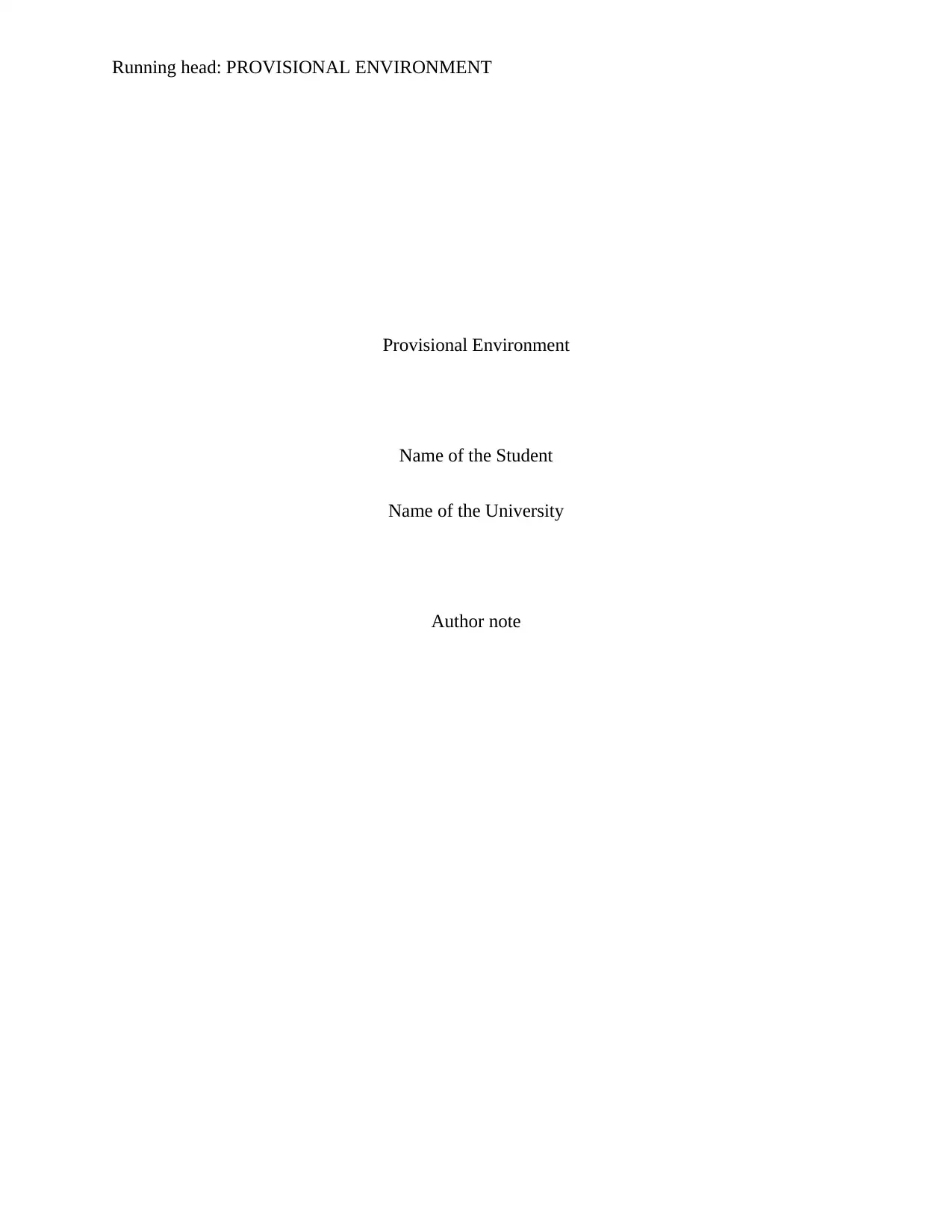
Running head: PROVISIONAL ENVIRONMENT
Provisional Environment
Name of the Student
Name of the University
Author note
Provisional Environment
Name of the Student
Name of the University
Author note
Secure Best Marks with AI Grader
Need help grading? Try our AI Grader for instant feedback on your assignments.
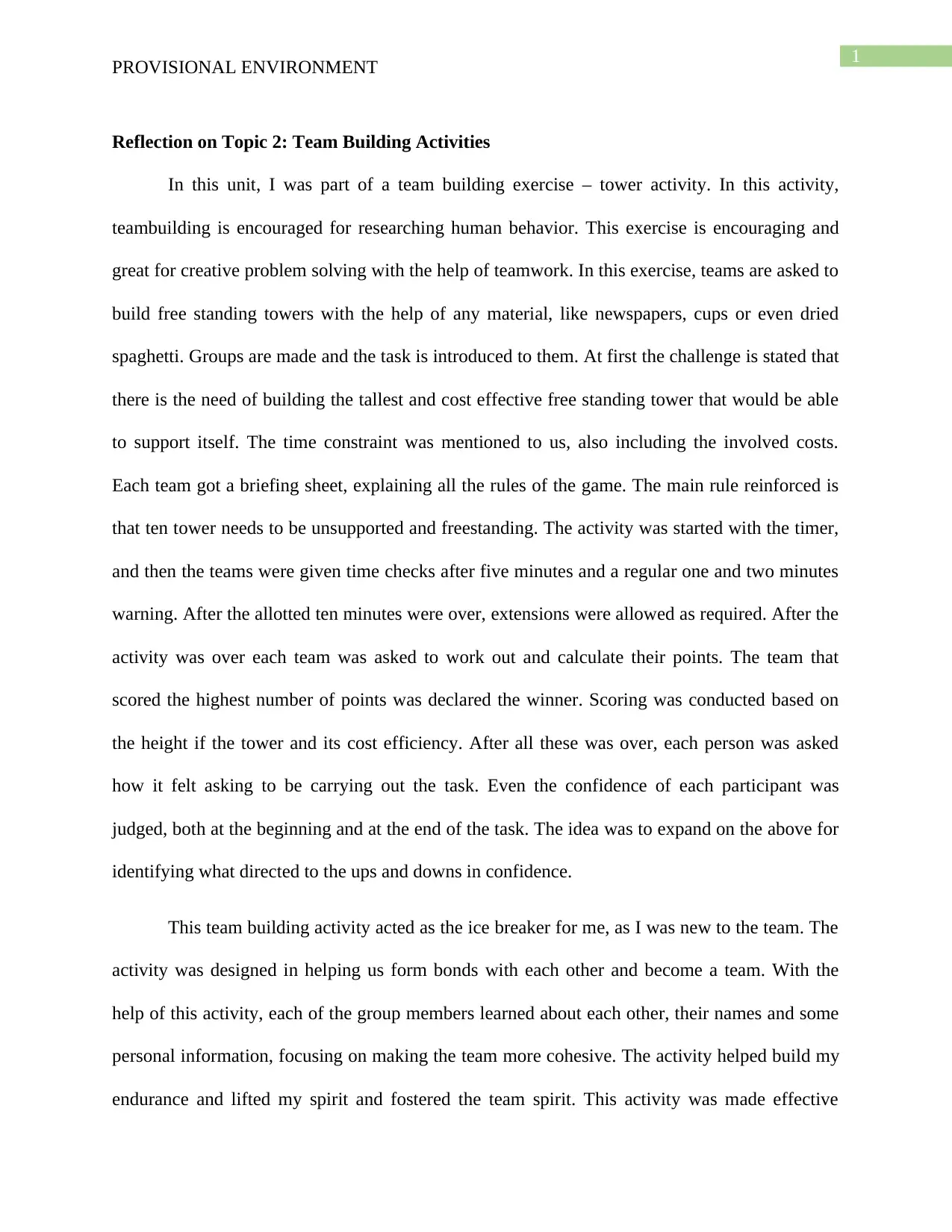
1
PROVISIONAL ENVIRONMENT
Reflection on Topic 2: Team Building Activities
In this unit, I was part of a team building exercise – tower activity. In this activity,
teambuilding is encouraged for researching human behavior. This exercise is encouraging and
great for creative problem solving with the help of teamwork. In this exercise, teams are asked to
build free standing towers with the help of any material, like newspapers, cups or even dried
spaghetti. Groups are made and the task is introduced to them. At first the challenge is stated that
there is the need of building the tallest and cost effective free standing tower that would be able
to support itself. The time constraint was mentioned to us, also including the involved costs.
Each team got a briefing sheet, explaining all the rules of the game. The main rule reinforced is
that ten tower needs to be unsupported and freestanding. The activity was started with the timer,
and then the teams were given time checks after five minutes and a regular one and two minutes
warning. After the allotted ten minutes were over, extensions were allowed as required. After the
activity was over each team was asked to work out and calculate their points. The team that
scored the highest number of points was declared the winner. Scoring was conducted based on
the height if the tower and its cost efficiency. After all these was over, each person was asked
how it felt asking to be carrying out the task. Even the confidence of each participant was
judged, both at the beginning and at the end of the task. The idea was to expand on the above for
identifying what directed to the ups and downs in confidence.
This team building activity acted as the ice breaker for me, as I was new to the team. The
activity was designed in helping us form bonds with each other and become a team. With the
help of this activity, each of the group members learned about each other, their names and some
personal information, focusing on making the team more cohesive. The activity helped build my
endurance and lifted my spirit and fostered the team spirit. This activity was made effective
PROVISIONAL ENVIRONMENT
Reflection on Topic 2: Team Building Activities
In this unit, I was part of a team building exercise – tower activity. In this activity,
teambuilding is encouraged for researching human behavior. This exercise is encouraging and
great for creative problem solving with the help of teamwork. In this exercise, teams are asked to
build free standing towers with the help of any material, like newspapers, cups or even dried
spaghetti. Groups are made and the task is introduced to them. At first the challenge is stated that
there is the need of building the tallest and cost effective free standing tower that would be able
to support itself. The time constraint was mentioned to us, also including the involved costs.
Each team got a briefing sheet, explaining all the rules of the game. The main rule reinforced is
that ten tower needs to be unsupported and freestanding. The activity was started with the timer,
and then the teams were given time checks after five minutes and a regular one and two minutes
warning. After the allotted ten minutes were over, extensions were allowed as required. After the
activity was over each team was asked to work out and calculate their points. The team that
scored the highest number of points was declared the winner. Scoring was conducted based on
the height if the tower and its cost efficiency. After all these was over, each person was asked
how it felt asking to be carrying out the task. Even the confidence of each participant was
judged, both at the beginning and at the end of the task. The idea was to expand on the above for
identifying what directed to the ups and downs in confidence.
This team building activity acted as the ice breaker for me, as I was new to the team. The
activity was designed in helping us form bonds with each other and become a team. With the
help of this activity, each of the group members learned about each other, their names and some
personal information, focusing on making the team more cohesive. The activity helped build my
endurance and lifted my spirit and fostered the team spirit. This activity was made effective

2
PROVISIONAL ENVIRONMENT
when I learned how to identify the challenges my team faces and the areas in which group
dynamics require to put in some extra work. It has helped me develop some clear goals for what
is required in getting out of the exercise. I understood what weaknesses I have that have
contributed to my biggest mistakes. I saw lack of open communication within the group and the
team members are not focused on individual achievement, nor on shared success. Even though
the team morale is good, and there is an easy camaraderie between everyone, people needs more
appreciation. Going through this exercise has helped in recognizing what are different areas that
we lack as a team and what can be done so that everyone works well together. Understanding has
been easy as I was open to feedback and even asked for it from other team members. Patterns
likely emerged, which ultimately helped me set my goals. Since the activity was not highly
competitive, there4 was no worst case scenario. The activity also did not entail and high level of
specialized skill as that would have turned people off who are not aware of how to do the activity
and strengthen the team. The lessons I learned from the team building activity needs
reinforcement and put to use to be back in business as always. Learning needs to be a huge part
of the culture and this single team building activity would not be enough. I have planned weekly
or monthly events so that the momentum that was created with this can be maintained.
Reflection on Topic 3: Cultural Awareness
In the present world of globalization and technological improvements, emphasis is put on
the importance of proper intercultural and interpersonal communication. Intercultural
communication skills are fast becoming the most important thing than ever before in the present
environment of organizations having an increasingly diverse workforce and wide travelling for
leisure and business. Several considerations coalesce for resulting in improved interpersonal
communication skills. The activity on increasing cultural awareness of intercultural
PROVISIONAL ENVIRONMENT
when I learned how to identify the challenges my team faces and the areas in which group
dynamics require to put in some extra work. It has helped me develop some clear goals for what
is required in getting out of the exercise. I understood what weaknesses I have that have
contributed to my biggest mistakes. I saw lack of open communication within the group and the
team members are not focused on individual achievement, nor on shared success. Even though
the team morale is good, and there is an easy camaraderie between everyone, people needs more
appreciation. Going through this exercise has helped in recognizing what are different areas that
we lack as a team and what can be done so that everyone works well together. Understanding has
been easy as I was open to feedback and even asked for it from other team members. Patterns
likely emerged, which ultimately helped me set my goals. Since the activity was not highly
competitive, there4 was no worst case scenario. The activity also did not entail and high level of
specialized skill as that would have turned people off who are not aware of how to do the activity
and strengthen the team. The lessons I learned from the team building activity needs
reinforcement and put to use to be back in business as always. Learning needs to be a huge part
of the culture and this single team building activity would not be enough. I have planned weekly
or monthly events so that the momentum that was created with this can be maintained.
Reflection on Topic 3: Cultural Awareness
In the present world of globalization and technological improvements, emphasis is put on
the importance of proper intercultural and interpersonal communication. Intercultural
communication skills are fast becoming the most important thing than ever before in the present
environment of organizations having an increasingly diverse workforce and wide travelling for
leisure and business. Several considerations coalesce for resulting in improved interpersonal
communication skills. The activity on increasing cultural awareness of intercultural
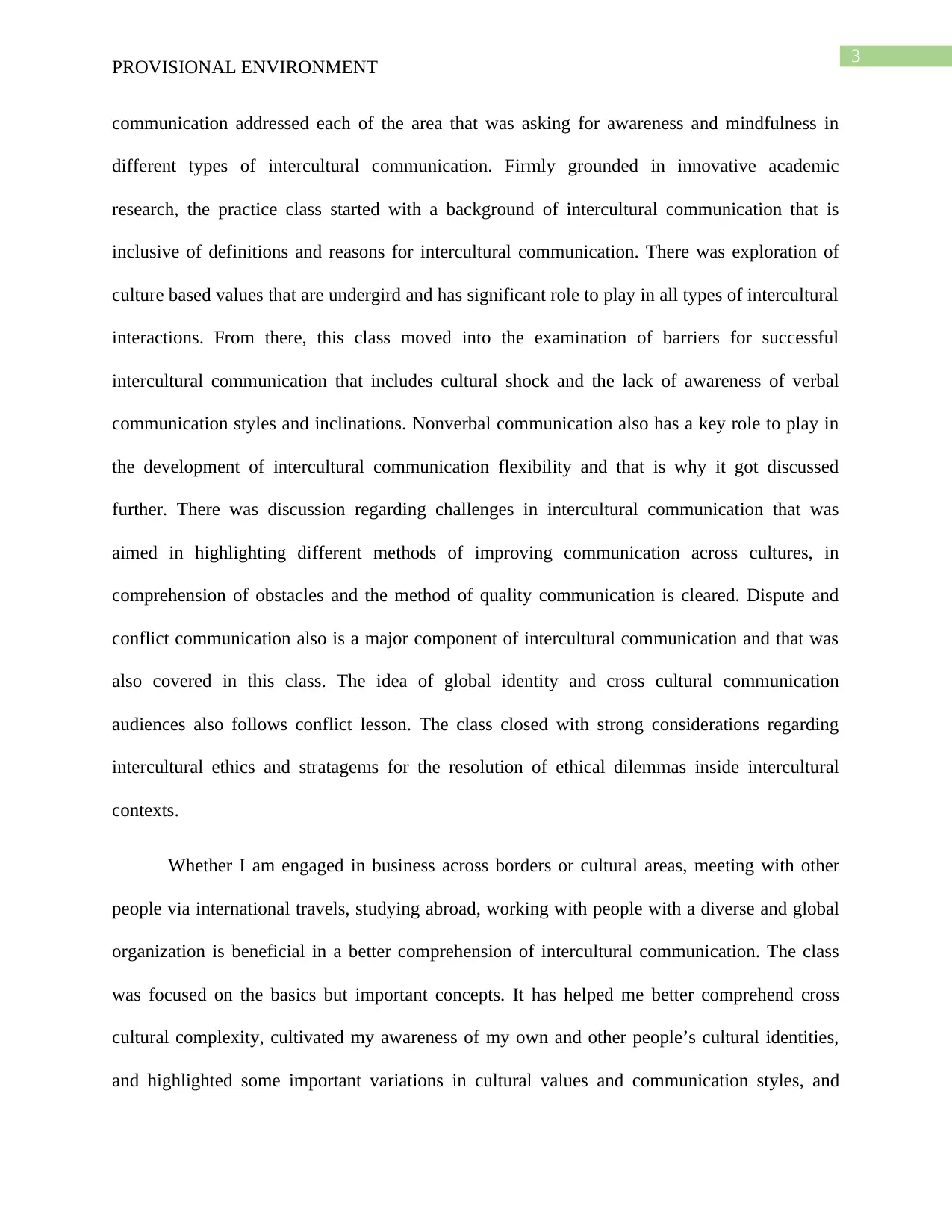
3
PROVISIONAL ENVIRONMENT
communication addressed each of the area that was asking for awareness and mindfulness in
different types of intercultural communication. Firmly grounded in innovative academic
research, the practice class started with a background of intercultural communication that is
inclusive of definitions and reasons for intercultural communication. There was exploration of
culture based values that are undergird and has significant role to play in all types of intercultural
interactions. From there, this class moved into the examination of barriers for successful
intercultural communication that includes cultural shock and the lack of awareness of verbal
communication styles and inclinations. Nonverbal communication also has a key role to play in
the development of intercultural communication flexibility and that is why it got discussed
further. There was discussion regarding challenges in intercultural communication that was
aimed in highlighting different methods of improving communication across cultures, in
comprehension of obstacles and the method of quality communication is cleared. Dispute and
conflict communication also is a major component of intercultural communication and that was
also covered in this class. The idea of global identity and cross cultural communication
audiences also follows conflict lesson. The class closed with strong considerations regarding
intercultural ethics and stratagems for the resolution of ethical dilemmas inside intercultural
contexts.
Whether I am engaged in business across borders or cultural areas, meeting with other
people via international travels, studying abroad, working with people with a diverse and global
organization is beneficial in a better comprehension of intercultural communication. The class
was focused on the basics but important concepts. It has helped me better comprehend cross
cultural complexity, cultivated my awareness of my own and other people’s cultural identities,
and highlighted some important variations in cultural values and communication styles, and
PROVISIONAL ENVIRONMENT
communication addressed each of the area that was asking for awareness and mindfulness in
different types of intercultural communication. Firmly grounded in innovative academic
research, the practice class started with a background of intercultural communication that is
inclusive of definitions and reasons for intercultural communication. There was exploration of
culture based values that are undergird and has significant role to play in all types of intercultural
interactions. From there, this class moved into the examination of barriers for successful
intercultural communication that includes cultural shock and the lack of awareness of verbal
communication styles and inclinations. Nonverbal communication also has a key role to play in
the development of intercultural communication flexibility and that is why it got discussed
further. There was discussion regarding challenges in intercultural communication that was
aimed in highlighting different methods of improving communication across cultures, in
comprehension of obstacles and the method of quality communication is cleared. Dispute and
conflict communication also is a major component of intercultural communication and that was
also covered in this class. The idea of global identity and cross cultural communication
audiences also follows conflict lesson. The class closed with strong considerations regarding
intercultural ethics and stratagems for the resolution of ethical dilemmas inside intercultural
contexts.
Whether I am engaged in business across borders or cultural areas, meeting with other
people via international travels, studying abroad, working with people with a diverse and global
organization is beneficial in a better comprehension of intercultural communication. The class
was focused on the basics but important concepts. It has helped me better comprehend cross
cultural complexity, cultivated my awareness of my own and other people’s cultural identities,
and highlighted some important variations in cultural values and communication styles, and
Secure Best Marks with AI Grader
Need help grading? Try our AI Grader for instant feedback on your assignments.
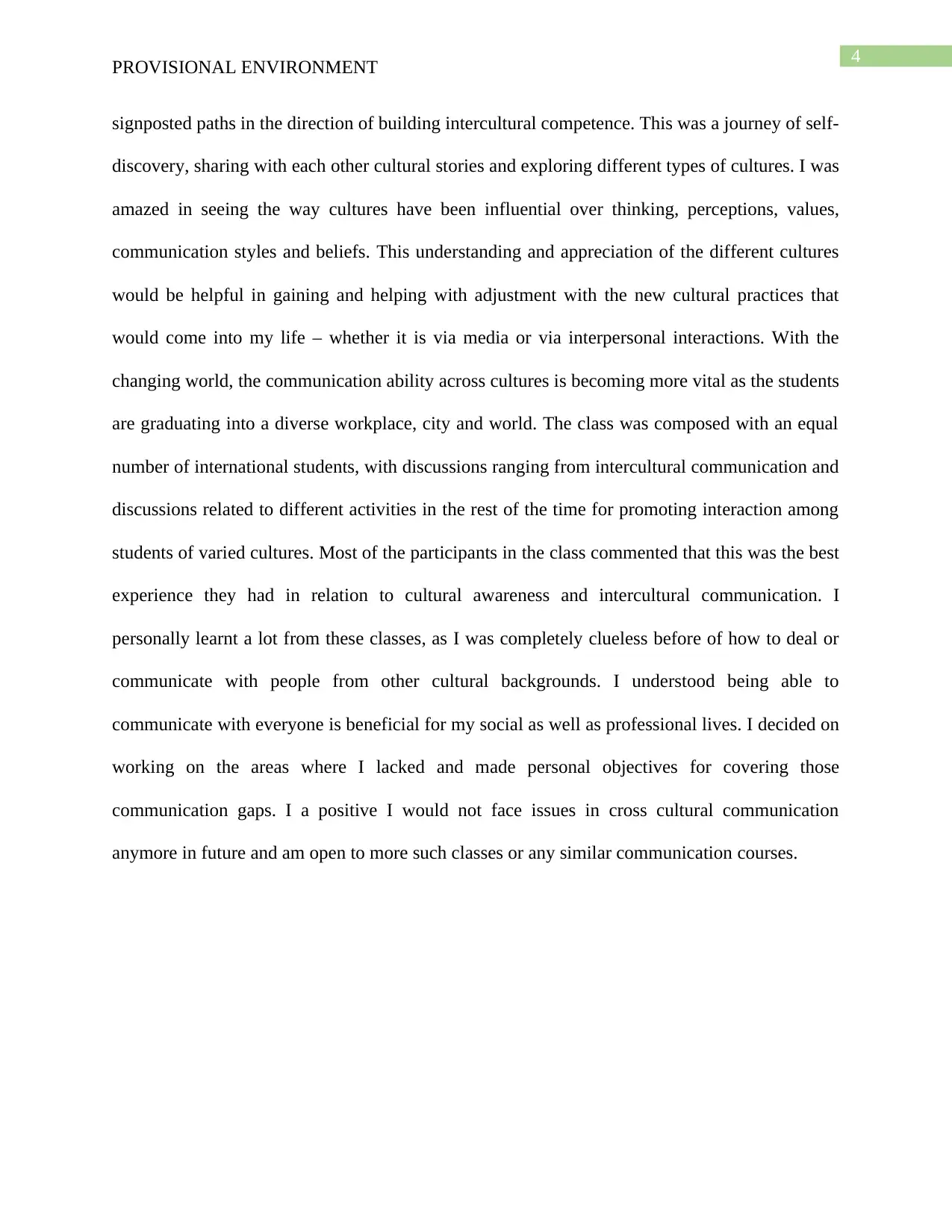
4
PROVISIONAL ENVIRONMENT
signposted paths in the direction of building intercultural competence. This was a journey of self-
discovery, sharing with each other cultural stories and exploring different types of cultures. I was
amazed in seeing the way cultures have been influential over thinking, perceptions, values,
communication styles and beliefs. This understanding and appreciation of the different cultures
would be helpful in gaining and helping with adjustment with the new cultural practices that
would come into my life – whether it is via media or via interpersonal interactions. With the
changing world, the communication ability across cultures is becoming more vital as the students
are graduating into a diverse workplace, city and world. The class was composed with an equal
number of international students, with discussions ranging from intercultural communication and
discussions related to different activities in the rest of the time for promoting interaction among
students of varied cultures. Most of the participants in the class commented that this was the best
experience they had in relation to cultural awareness and intercultural communication. I
personally learnt a lot from these classes, as I was completely clueless before of how to deal or
communicate with people from other cultural backgrounds. I understood being able to
communicate with everyone is beneficial for my social as well as professional lives. I decided on
working on the areas where I lacked and made personal objectives for covering those
communication gaps. I a positive I would not face issues in cross cultural communication
anymore in future and am open to more such classes or any similar communication courses.
PROVISIONAL ENVIRONMENT
signposted paths in the direction of building intercultural competence. This was a journey of self-
discovery, sharing with each other cultural stories and exploring different types of cultures. I was
amazed in seeing the way cultures have been influential over thinking, perceptions, values,
communication styles and beliefs. This understanding and appreciation of the different cultures
would be helpful in gaining and helping with adjustment with the new cultural practices that
would come into my life – whether it is via media or via interpersonal interactions. With the
changing world, the communication ability across cultures is becoming more vital as the students
are graduating into a diverse workplace, city and world. The class was composed with an equal
number of international students, with discussions ranging from intercultural communication and
discussions related to different activities in the rest of the time for promoting interaction among
students of varied cultures. Most of the participants in the class commented that this was the best
experience they had in relation to cultural awareness and intercultural communication. I
personally learnt a lot from these classes, as I was completely clueless before of how to deal or
communicate with people from other cultural backgrounds. I understood being able to
communicate with everyone is beneficial for my social as well as professional lives. I decided on
working on the areas where I lacked and made personal objectives for covering those
communication gaps. I a positive I would not face issues in cross cultural communication
anymore in future and am open to more such classes or any similar communication courses.
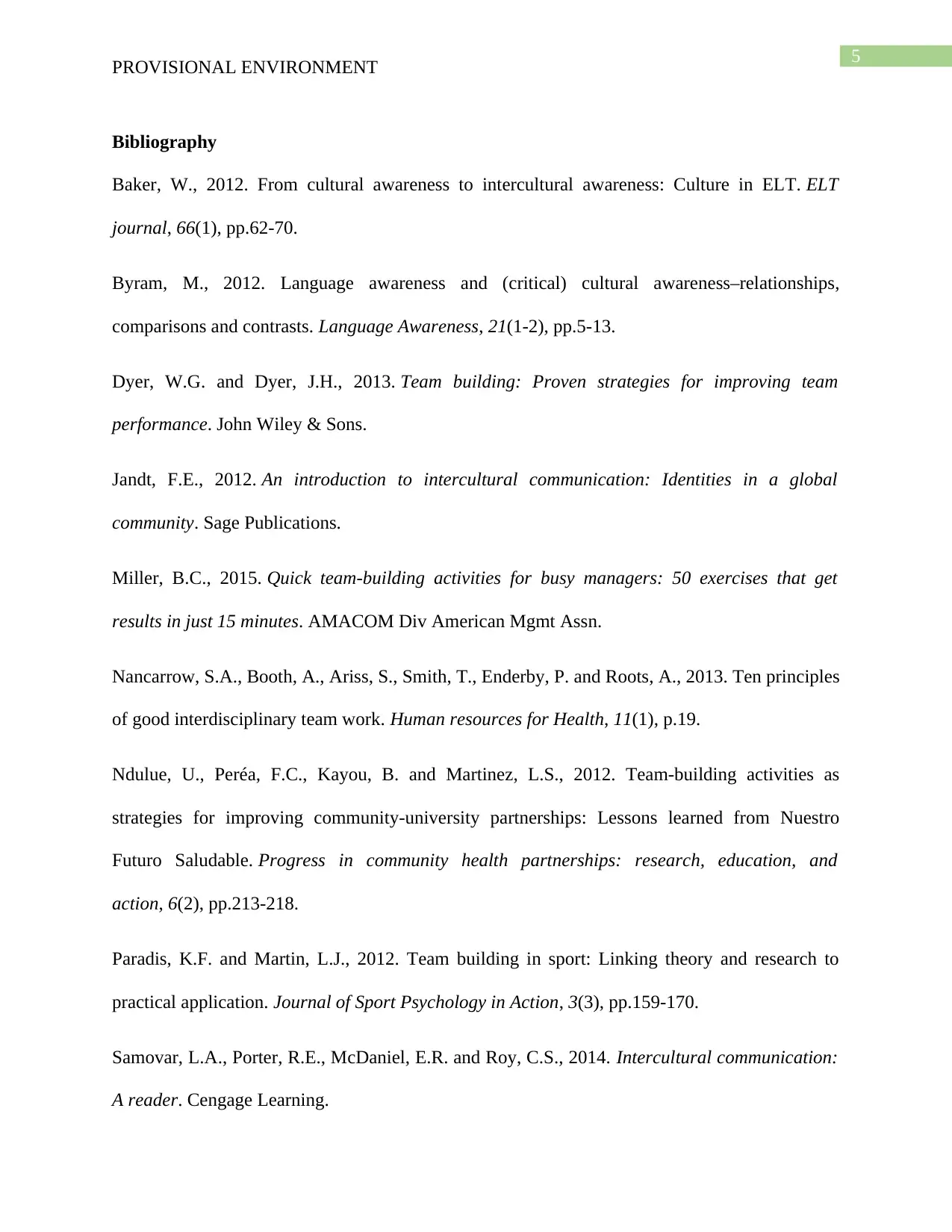
5
PROVISIONAL ENVIRONMENT
Bibliography
Baker, W., 2012. From cultural awareness to intercultural awareness: Culture in ELT. ELT
journal, 66(1), pp.62-70.
Byram, M., 2012. Language awareness and (critical) cultural awareness–relationships,
comparisons and contrasts. Language Awareness, 21(1-2), pp.5-13.
Dyer, W.G. and Dyer, J.H., 2013. Team building: Proven strategies for improving team
performance. John Wiley & Sons.
Jandt, F.E., 2012. An introduction to intercultural communication: Identities in a global
community. Sage Publications.
Miller, B.C., 2015. Quick team-building activities for busy managers: 50 exercises that get
results in just 15 minutes. AMACOM Div American Mgmt Assn.
Nancarrow, S.A., Booth, A., Ariss, S., Smith, T., Enderby, P. and Roots, A., 2013. Ten principles
of good interdisciplinary team work. Human resources for Health, 11(1), p.19.
Ndulue, U., Peréa, F.C., Kayou, B. and Martinez, L.S., 2012. Team-building activities as
strategies for improving community-university partnerships: Lessons learned from Nuestro
Futuro Saludable. Progress in community health partnerships: research, education, and
action, 6(2), pp.213-218.
Paradis, K.F. and Martin, L.J., 2012. Team building in sport: Linking theory and research to
practical application. Journal of Sport Psychology in Action, 3(3), pp.159-170.
Samovar, L.A., Porter, R.E., McDaniel, E.R. and Roy, C.S., 2014. Intercultural communication:
A reader. Cengage Learning.
PROVISIONAL ENVIRONMENT
Bibliography
Baker, W., 2012. From cultural awareness to intercultural awareness: Culture in ELT. ELT
journal, 66(1), pp.62-70.
Byram, M., 2012. Language awareness and (critical) cultural awareness–relationships,
comparisons and contrasts. Language Awareness, 21(1-2), pp.5-13.
Dyer, W.G. and Dyer, J.H., 2013. Team building: Proven strategies for improving team
performance. John Wiley & Sons.
Jandt, F.E., 2012. An introduction to intercultural communication: Identities in a global
community. Sage Publications.
Miller, B.C., 2015. Quick team-building activities for busy managers: 50 exercises that get
results in just 15 minutes. AMACOM Div American Mgmt Assn.
Nancarrow, S.A., Booth, A., Ariss, S., Smith, T., Enderby, P. and Roots, A., 2013. Ten principles
of good interdisciplinary team work. Human resources for Health, 11(1), p.19.
Ndulue, U., Peréa, F.C., Kayou, B. and Martinez, L.S., 2012. Team-building activities as
strategies for improving community-university partnerships: Lessons learned from Nuestro
Futuro Saludable. Progress in community health partnerships: research, education, and
action, 6(2), pp.213-218.
Paradis, K.F. and Martin, L.J., 2012. Team building in sport: Linking theory and research to
practical application. Journal of Sport Psychology in Action, 3(3), pp.159-170.
Samovar, L.A., Porter, R.E., McDaniel, E.R. and Roy, C.S., 2014. Intercultural communication:
A reader. Cengage Learning.
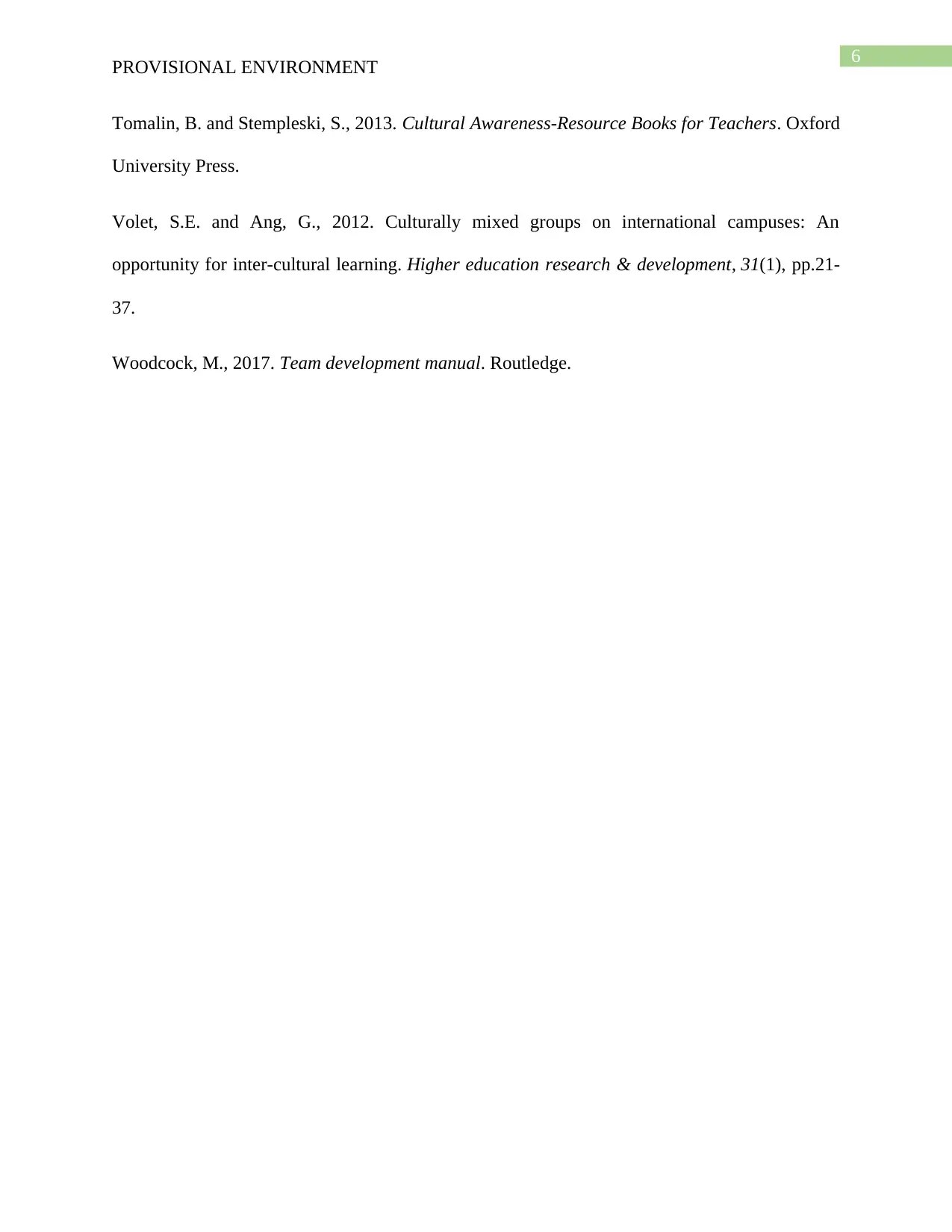
6
PROVISIONAL ENVIRONMENT
Tomalin, B. and Stempleski, S., 2013. Cultural Awareness-Resource Books for Teachers. Oxford
University Press.
Volet, S.E. and Ang, G., 2012. Culturally mixed groups on international campuses: An
opportunity for inter-cultural learning. Higher education research & development, 31(1), pp.21-
37.
Woodcock, M., 2017. Team development manual. Routledge.
PROVISIONAL ENVIRONMENT
Tomalin, B. and Stempleski, S., 2013. Cultural Awareness-Resource Books for Teachers. Oxford
University Press.
Volet, S.E. and Ang, G., 2012. Culturally mixed groups on international campuses: An
opportunity for inter-cultural learning. Higher education research & development, 31(1), pp.21-
37.
Woodcock, M., 2017. Team development manual. Routledge.
1 out of 7
Related Documents
Your All-in-One AI-Powered Toolkit for Academic Success.
+13062052269
info@desklib.com
Available 24*7 on WhatsApp / Email
![[object Object]](/_next/static/media/star-bottom.7253800d.svg)
Unlock your academic potential
© 2024 | Zucol Services PVT LTD | All rights reserved.





